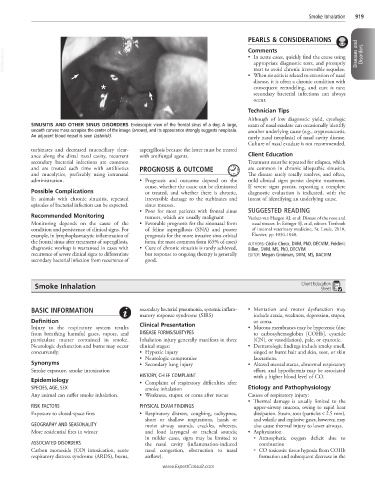Page 1834 - Cote clinical veterinary advisor dogs and cats 4th
P. 1834
Smoke Inhalation 919
PEARLS & CONSIDERATIONS
VetBooks.ir Comments Diseases and Disorders
• In acute cases, quickly find the cause using
appropriate diagnostic tests, and promptly
treat to avoid chronic irreversible sequelae.
• When sinusitis is related to extension of nasal
disease, it is often a chronic condition with
* consequent remodeling, and cure is rare;
secondary bacterial infections can always
occur.
Technician Tips
Although of low diagnostic yield, cytologic
SINUSITIS AND OTHER SINUS DISORDERS Endoscopic view of the frontal sinus of a dog. A large, exam of nasal exudate can occasionally identify
smooth convex mass occupies the center of the image (arrows), and its appearance strongly suggests neoplasia. another underlying cause (e.g., cryptococcosis,
An adjacent blood vessel is seen (asterisk). rarely nasal neoplasia) of nasal cavity disease.
Culture of nasal exudate is not recommended.
turbinates and decreased mucociliary clear- aspergillosis because the latter must be treated
ance along the distal nasal cavity, recurrent with antifungal agents. Client Education
secondary bacterial infections are common Treatment must be repeated for relapses, which
and are treated each time with antibiotics PROGNOSIS & OUTCOME are common in chronic idiopathic sinusitis.
and mucolytics, preferably using intranasal The disease rarely totally resolves, and often,
administration. • Prognosis and outcome depend on the mild clinical signs persist despite treatment.
cause, whether the cause can be eliminated If severe signs persist, repeating a complete
Possible Complications or treated, and whether there is chronic, diagnostic evaluation is indicated, with the
In animals with chronic sinusitis, repeated irreversible damage to the turbinates and intent of identifying an underlying cause.
episodes of bacterial infection can be expected. sinus mucosa.
• Poor for most patients with frontal sinus SUGGESTED READING
Recommended Monitoring tumors, which are usually malignant Venker-van Haagen AJ, et al: Disease of the nose and
Monitoring depends on the cause of the • Favorable prognosis for the sinonasal form nasal sinuses. In Ettinger SJ, et al, editors. Textbook
condition and persistence of clinical signs. For of feline aspergillosis (SNA) and poorer of internal veterinary medicine, St. Louis, 2010,
example, in lymphoplasmacytic inflammation of prognosis for the more invasive sino-orbital Elsevier, pp 1030-1040.
the frontal sinus after treatment of aspergillosis, form, the most common form (65% of cases) AUTHORS: Cécile Clercx, DVM, PhD, DECVIM; Frédéric
diagnostic workup is warranted in cases with • Cure of chronic sinusitis is rarely achieved, Billen, DVM, MS, PhD, DECVIM
recurrence of severe clinical signs to differentiate but response to ongoing therapy is generally EDITOR: Megan Grobman, DVM, MS, DACVIM
secondary bacterial infection from recurrence of good.
Smoke Inhalation Client Education
Sheet
BASIC INFORMATION secondary bacterial pneumonia, systemic inflam- • Mentation and motor dysfunction may
matory response syndrome (SIRS) include ataxia, weakness, depression, stupor,
Definition or coma.
Injury to the respiratory system results Clinical Presentation • Mucous membranes may be hyperemic (due
from breathing harmful gases, vapors, and DISEASE FORMS/SUBTYPES to carboxyhemoglobin [COHb], cyanide
particulate matter contained in smoke. Inhalation injury generally manifests in three [CN], or vasodilation), pale, or cyanotic.
Neurologic dysfunction and burns may occur clinical stages: • Dermatologic findings include smoky smell,
concurrently. • Hypoxic injury singed or burnt hair and skin, soot, or skin
• Neurologic compromise lacerations.
Synonyms • Secondary lung injury • Altered mental status, abnormal respiratory
Smoke exposure, smoke intoxication effort, and hypothermia may be associated
HISTORY, CHIEF COMPLAINT with a higher blood level of CO.
Epidemiology • Complaint of respiratory difficulties after
SPECIES, AGE, SEX smoke inhalation Etiology and Pathophysiology
Any animal can suffer smoke inhalation. • Weakness, stupor, or coma after rescue Causes of respiratory injury:
• Thermal damage is usually limited to the
RISK FACTORS PHYSICAL EXAM FINDINGS upper-airway mucosa, owing to rapid heat
Exposure to closed-space fires • Respiratory distress, coughing, tachypnea, dissipation. Steam, soot (particles < 2.5 mm),
short or shallow respirations, harsh or and volatile and explosive gases, however, may
GEOGRAPHY AND SEASONALITY moist airway sounds, crackles, wheezes, also cause thermal injury to lower airways.
More residential fires in winter and loud laryngeal or tracheal sounds; • Asphyxiation
in milder cases, signs may be limited to ○ Atmospheric oxygen deficit due to
ASSOCIATED DISORDERS the nasal cavity (inflammation-induced combustion
Carbon monoxide (CO) intoxication, acute nasal congestion, obstruction to nasal ○ CO toxicosis: tissue hypoxia from COHb
respiratory distress syndrome (ARDS), burns, airflow). formation and subsequent decrease in the
www.ExpertConsult.com

